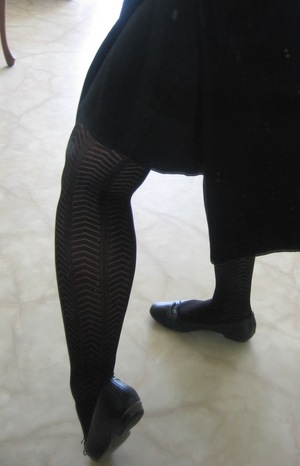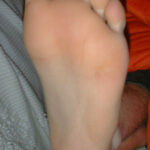Muscle twitching? Do calf dents have you terrified? Calf dents are also sometimes referred to as indentations. But the preferred term for apparent (yes, note the word “apparent”) calf muscle atrophy is calf dent. If you have clicked on this article, then you are most likely already deep within the agony of ALS fear originating from twitching muscles. So fearful are you that maybe you have ALS, that you’ve begun checking your lower legs for muscle atrophy.
Muscle twitching aside, you have discovered dents in one of your calves, or maybe just one dent there, and are wondering why the other calf doesn’t have the same dent or groove. Could this be a sign of muscle atrophy in the calf with the dent? NO. What’s really happening is that your mind is playing tricks on you, all because you probably googled muscle twitching. Though muscle atrophy is the result of ALS, a dent in a calf is not a hallmark sign of muscle atrophy.
Here is how this whole frightening process develops:
1) A person’s lower leg muscle begins twitching. The twitching muscle persists and eventually becomes annoying enough that the person begins wondering, “Why on earth is my calf twitching?”
2) He or she then gets online and does a Google on calf muscle twitching. A bunch of links, containing the keywords of calf muscle twitching, comes up.
3) He or she anticipated some simple remedy for the twitching, such as maybe more water, a self-massage, or maybe the cause of twitching muscles is a mineral deficiency. But instead, as this person scrolls down the page of links, he discovers that fasciculations are a symptom of ALS, an always-fatal motor neuron disease that causes atrophy.
4) Panic strikes, and he becomes consumed with visiting all the ALS medical sites to learn more about this horrible disease. The more they read about ALS, the more they’re convinced they have ALS.
5) The twitching in the lower leg now becomes more pronounced. Not only that, but other areas of the body begin twitching. The muscle twitching has “spread.”
6) Once the person learns that another chief ALS symptom besides fasciculations is muscle weakness (from atrophy, or wasting away of muscle), they then begin checking the twitching calf for signs of atrophy. Inspecting for atrophy becomes an obsession.
7) Invariably, the person will discover dents in the affected calf, that are not present in the other lower leg. Conclusions: 1) Dents absolutely mean muscle atrophy; and 2) Atrophy manifests as dents.
8) The person spends a lot of time comparing both lower legs, measuring the calf dent or dents, examining the leg dent from different angles, pulling at the skin around it to see what happens, pressing it, etc. Lengthy inspections can be done dozens of times per day, because the individual is constantly seeking reassurance that maybe, just maybe, he/she is NOT dying from ALS afterall.
If this sounds like you, here THIS: Calf dents are normal. It’s called muscle definition. If you don’t believe me, open a fitness or bodybuilding magazine and look at the legs. They are full of dents. Calf dents galore. In fact, check out magazines on running or soccer. People with low body fat, and especially with toned muscles from running, athletics or weight exercises, will have lower leg dents.
Bodybuilders, physique and figure competitors strive for calf dents as well as grooves everywhere else. In fact, their jargon for calf dents is striations, cuts and rips. As a personal trainer, I have had clients who, upon discovering dents in their legs and arms, became ecstatic and pointed them out to me: “Look! I never had this before!” IT’S MUSCLE DEFINITION.
And in your case, you just never noticed it before. Muscle definition fluctuates. So even if you know you never had a calf dent before, this is no cause for alarm. Because muscle definition is variable over time, due to fluctuating eating habits, fluctuating exercise habits, and other factors that affect body composition.
The body is NOT symmetrical. Examine the moles on your lower leg. Do you have the exact same pattern of moles on your other leg? One calf is probably bigger than the other, too. Gee, I see this ALL the time in someone walking ahead of me. Like you have a dominant arm, you have a dominant leg. The dominant leg may have more dents in the calf, reflecting slightly more toned muscles and/or less fat (NOT atrophy!).
If your less dominant calf has more dents, this does not mean muscle atrophy. It means natural asymmetry, which may be the result of maybe a little less fat there. (The less fat between skin and muscle, the more muscle definition you’ll have.) Or maybe your “non-dominant” leg is more dominant than you think!
For example, suppose your right leg is stronger than your left, as far as push-power. This, however, does not mean that your left leg can’t be superior in some other aspect, such as balancing on one foot or taking off in a leap.
Calf dents are normal. If you want to know what muscle atrophy REALLY looks like, look at the legs of someone in a wheelchair. I’ve seen many people’s bare lower legs, who were confined to wheelchairs, or who were walking but had either a stroke or cerebral palsy. If anything, their atrophied calves had NO dents!
Atrophied muscle that has turned flaccid and limp is dentless, because it’s not firm enough to show definition. As for muscle twitching meaning you might have ALS, this is like thinking that a spell of flatulence (farting) must mean you have colon cancer. You can’t take such a drastic jump in conclusions. Muscle twitching has many, many, far more common causes than ALS, namely: 1) stress, 2) exercise, 3) dehydration, 4) insufficient calcium intake, 5) mineral imbalance (magnesium, potassium), and 6) no known cause; just something that happens.
If you found this article on calf dents, twitching and atrophy helpful, you’ll benefit from reading my other articles on muscle twitching – Here



